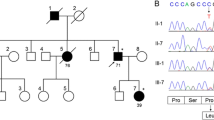Abstract
Background
Spinal cerebellar ataxia 11 (SCA11) is a rare disease, characterized by progressive cerebellar ataxia, abnormal eye sign. Four families have been reported in the past. We report on China’s first family with spinocerebellar ataxia 11.
Methods
A careful investigation of the clinical manifestations, brain imaging, and exome and Sanger sequencing were utilized to identify pathogenic genetic variants in a three-generation pedigree that includes 5 affected individuals.
Results
The proband and affected members began to develop cerebellar ataxia, dysarthria, nystagmus, and strabismus at approximately age 40 for no apparent reason. The lifespan of patients in the family is shortened. Brain MRIs showed cerebellar atrophy and slight atrophy of the bulbar medulla. Electromyography showed extensive neurogenic damage. Sensory evoked potentials of lower limbs showed damage to the spinal-brainstem-cortical conduction pathway. Genetic analysis revealed a novel point mutation (c.3290T>C) in the TTBK2 gene encoding tau-microtubule kinase 2, which led to an amino acid exchange (p.Val1097Ala). The missense mutation segregated with the phenotype. The mutation has a very low mutation rate in the population, the variant amino acids are highly conserved among species, and protein function damage prediction at the mutation site is detrimental and is highly likely to cause protein damage. The pathogenicity prediction of the mutation site shows that it is likely to cause disease. This variation is consistent with the diagnosis of SCA11.
Conclusion
The first SCA11-affected family in China was characterized by gait instability, movement disorders and dysarthria with obvious cerebellar atrophy. The pathogenic allele was a c.3290T>C mutation in the TTBK2 gene.



Similar content being viewed by others
Abbreviations
- SCA11:
-
Spinocerebellar ataxia 11
- SCA3:
-
Spinocerebellar ataxia 3
- ADCA:
-
Autosomal dominant cerebellar ataxia
- TTBK2:
-
tau-tubulin kinase2
- IP3:
-
inositol triphosphate
- gsk-3β:
-
Glycogen synthase kinase-3β
- MRI:
-
Magnetic resonance imaging
- NGS:
-
next-generation sequencing
- EMG:
-
electromyography
- CK:
-
creatinine kinase
- ATXN7 :
-
The pathogenic gene of spinocerebellar ataxia-7
- DARS2 :
-
Pathogenic genes of leukocephalopathy with brain stem and spinal cord involvement and lactate elevation
- MRA:
-
Magnetic resonance angiography
- EMG:
-
Electromyography
- RNS:
-
repeated nerve stimulation
References
Bird T D . Hereditary ataxia overview [M]// GeneReviews™. PubMed, 2008. DOI:https://doi.org/10.1038/gim.2013.28
Krysa Wioletta, Sulek Anna, Rakowicz Maria et al. High relative frequency of SCA1 in Poland reflecting a potential founder effect.[J] .Neurol Sci, 2016, 37: 1319–1325. DOI:https://doi.org/10.1007/s10072-016-2594-x
Wang J, Shen L, Lei L, Xu Q, Zhou J, Liu Y, Guan W, Pan Q, Xia K, Tang B, Jiang H (2011) Spinocerebellar ataxias in mainland China: an updated genetic analysis among a large cohort of familial and sporadic cases. [J]. Zhong Nan Da Xue Xue Bao Yi Xue Ban 36(6):482–489. https://doi.org/10.3969/j.issn.1672-7347.2011.06.003
Anderson KV (2012) The spinocerebellar ataxia-associated gene tau tubulin kinase 2 controls the initiation of ciliogenesis. [J]. Cell 151(4):847–858. https://doi.org/10.1016/j.cell.2012.10.010
Jung-Chi L, Tony YT, Roc WR et al (2015) TTBK2: a tau protein kinase beyond tau phosphorylation[J]. Biomed Res Int 2015:1–10. https://doi.org/10.1155/2015/575170
Houlden H, Johnson J, Gardner-Thorpe C, Lashley T, Hernandez D, Worth P, Singleton AB, Hilton DA, Holton J, Revesz T, Davis MB, Giunti P, Wood NW (2008) Mutations in TTBK2, encoding a kinase implicated in tau phosphorylation, segregate with spinocerebellar ataxia type 11. [J]. Nat Genet 39(12):1434–1436. https://doi.org/10.1038/ng.2007.43
Ikezu S, Ikezu T (2014) Tau-tubulin kinase. Front Mol Neurosci 7:33. https://doi.org/10.3389/fnmol.2014.00033
Kitanotakahashi M, Morita H, Kondo S et al (2007) Expression, purification and crystallization of a human tau-tubulin kinase 2 that phosphorylates tau protein[J]. Acta Crystallogr Sect F Struct Biol Cryst Commun 63(7):602–604. https://doi.org/10.1107/S1744309107028783
Leemput JVD, Chandran J, Knight MA et al (2007) Deletion at, ITPR1, underlies Ataxia in mice and spinocerebellar ataxia 15 in humans[J]. PLoS Genet 3(6):e108. https://doi.org/10.1371/journal.pgen.0030108
Lindquist SG, Mueller LB, Dali CI et al (2017) A novel TTBK2 de novo mutation in a Danish family with early-onset spinocerebellar Ataxia[J]. Cerebellum 16(1):268–271. https://doi.org/10.1007/s12311-016-0786-9
Bauer P, Stevanin G, Beetz C et al (2010) Spinocerebellar ataxia type 11 (SCA11) is an uncommon cause of dominant ataxia among French and German kindreds[J]. J Neurol Neurosurg Psychiatry 81(11):1229–1232. https://doi.org/10.1136/jnnp.2009.202150
Johnson J, Wood N, Giunti P et al (2008) Clinical and genetic analysis of spinocerebellar ataxia type 11[J]. Cerebellum 7(2):159–164. https://doi.org/10.1007/s12311-008-0022-3
Xu Q, Li X, Wang J et al (2010) Spinocerebellar ataxia type 11 in the Chinese Han population[J]. Neurol Sci 31(1):107–109. https://doi.org/10.1007/s10072-009-0129-4
Edener U, Kurth I, Meiner A et al (2009) Missense exchanges in the TTBK2 gene mutated in SCA11[J]. J Neurol 256(11):1856–1859. https://doi.org/10.1007/s00415-009-5209-0
Acknowledgments
The authors wish to thank the patient and her family members for cooperation.
Availability of data and materials
The datasets generated and analyzed during the current study are available from the corresponding author on reasonable request.
Author information
Authors and Affiliations
Contributions
YD, JF, and YZ performed the acquisition of data and analytical studies, and wrote the manuscript; XQ and MZ conducted and performed the periodic clinical monitoring; XQ planned the study, checked the final form of the manuscript, and approved the final manuscript. All authors read and approved the final manuscript.
Corresponding author
Ethics declarations
Ethics approval and consent to participate
This study was approved by the ethics committee of The Second Affiliated Hospital of Nanchang University. A written informed consent form was obtained from each study participant.
Consent to publication
Not applicable.
Competing interests
The authors declare that they have no competing interests.
Additional information
Publisher’s note
Springer Nature remains neutral with regard to jurisdictional claims in published maps and institutional affiliations.
Rights and permissions
About this article
Cite this article
Deng, Y., Fu, J., Zhong, Y. et al. First finding of familial spinal cerebellar Ataxia11 in China: clinical, imaging and genetic features. Neurol Sci 41, 155–160 (2020). https://doi.org/10.1007/s10072-019-04052-6
Received:
Accepted:
Published:
Issue Date:
DOI: https://doi.org/10.1007/s10072-019-04052-6




